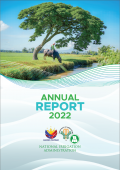NIA Central Office – To avoid palay losses during typhoon months, and "squeeze in" two rice crops during the dry season, the National Irrigation Administration (NIA) will promote adjusting the traditional rice planting calendar.
In recent years, the country has lost an average of 500,000 to 600,000 metric tons (MT) of palay (unmilled rice) annually due to typhoons and floods that mostly occur in September to October when the wet season crop is ready for harvest, according to the Department of Agriculture (DA).
"Such volume could be saved if farmers were to plant in October to November, rather than the traditional months of June and July, which could then be harvested in January and February the following year," said NIA Administrator Engr. Eduardo Eddie G. Guillen.
"Further, the country could produce more rice if farmers, particularly in irrigated areas, would quickly turn around and plant a second crop that may be harvested in May and June, before the height of the rainy season," he added.
"Many of our trained and progressive farmers, who are members of our Irrigators' Associations (IAs) have already been practicing the said 'quick turn around' or QTA technology, that has enabled them to plant and harvest two rice crops in one dry season," added Guillen, who previously served as municipal mayor of Piddig, Ilocos Norte.
Rice yields are generally higher during the dry season as longer sunshine promotes better crop growth. Further, water availability can be efficiently controlled through irrigation, and more importantly avoid crop damage from too much rain, floods and typhoons. Studies and field tests show that average palay yield during the dry season is higher by one-half ton to 1.5 tons per hectare.
Generally, Administrator Guillen said that the adjustment of the planting calendar aims to establish a double dry season cropping cycle, followed by a longer fallow period during the rainy and typhoon season, when farmers could plant cash crops in lieu of rice. Also, he said the adjusted planting calendar allows for soil nutrients to be replenished and prepares the land for the next two consecutive dry cropping season.
For Crop Year (CY) 2025, the NIA targets to cover more than 1 million hectares (1,073,646.63 ha) for the first dry season and about 355,271.42 hectares for the second dry season, and more than 1.263 million hectares (1,263,106.34 ha) for the regular wet season. Thorough planning, consultations, and assessments have been conducted among hundreds of IAs nationwide and the NIA would continue to encourage more IAs to ensure success of the adjusted planting calendar for each region, Administrator Guillen said.
"We aim to increase our average cropping intensity from the current 1.6 to at least two, and this would subsequently increase the country's national palay production annually," the NIA chief concluded.
#bayaNIAn sa #BagongPilipinas
For more information and/or inquiries, please contact:
OFFICE OF THE PUBLIC AFFAIRS AND INFORMATION STAFF
National Irrigation Administration
EDSA, Diliman, Quezon City
Telephone Number: (02) 8921-3741, (02) 8929-6071 to 79 loc. 113
Email: pais@nia.gov.ph

















